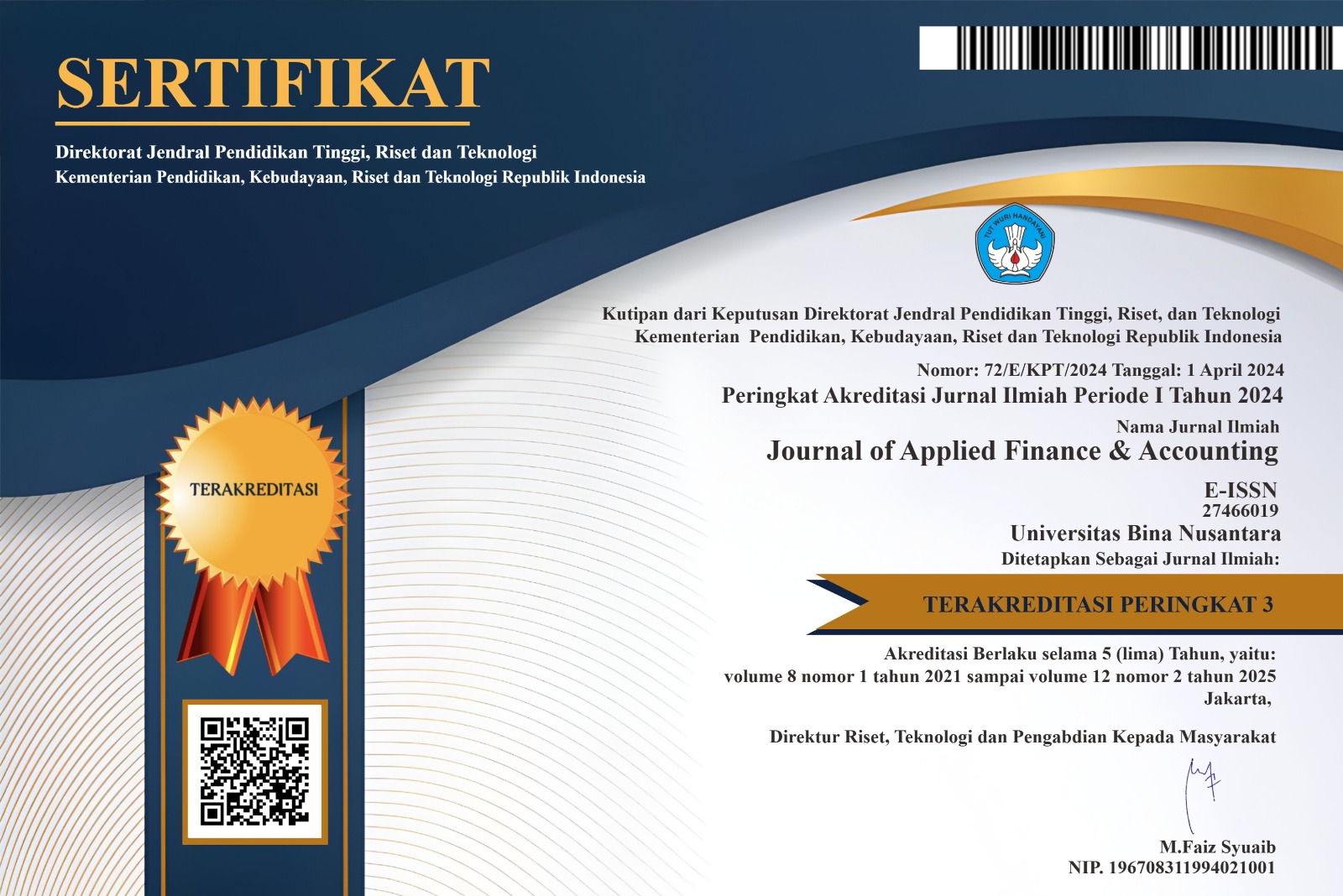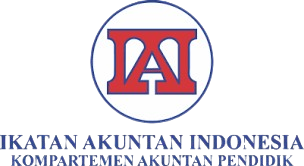THE COMPARATIVE ANALYSIS OF FINANCIAL PERFORMANCE AND TRADING VOLUME DURING MERS AND COVID-19 ON THE INDONESIA AND MALAYSIA STOCK EXCHANGE
DOI:
https://doi.org/10.21512/jafa.v8i2.8153Keywords:
Financial Performance, Trading Volume Activity, MERS, COVID-19Abstract
We investigate the differences of financial performance and stock trading volume during the MERS and COVID-19 periods on the Indonesia and Malaysia Stock Exchanges. We used Wilcoxon Signed Rank Test. Wilcoxon Signed Rank Test model is selected because we compared Indonesia and Malaysia to conduct a paired difference test of repeated measurements on a single sample to assess whether their population mean ranks differ. Our sample consist of 140 companies that getting from 713 companies listed in the Indonesia Stock Exchange while Malaysia is composed of 345 companies from 597 listed company in Malaysia Stock Exchange. The results showed that MERS and COVID-19 have differences in total asset turnover (TATO) and stock trading volume on the Indonesia and Malaysia Stock Exchanges, while the Current Ratio as liquidity ratio and Debt to equity ratio as risk proxy have no differences on the Indonesia and Malaysia Stock Exchange. There is no difference in the operating Profit Margin as profitability ratio variable on the Indonesia Stock Exchange while there is a significant difference on the Malaysia Stock Exchange.
References
Abdul, & Hidayat, N. (2000). Studi Empiris Tentang Pengaruh Volume Perdagangan Dan Return Terhadap Bid-Ask Spread Industri Rokok Di Bursa Efek Jakarta Dengan Model Koreksi Kesalahan. Jurnal Riset Akuntansi Indonesia, 3(1), 69–85.
Aisyah, N. N., Kristanti, F. T., & Zultilisna, D. (2017). Pengaruh rasio likuiditas, rasio aktivitas, rasio profitabiltas, dan rasio l leverage terhadap financial distress (studi pada perusahaan tekstil dan garmen yang terdaftar di bursa efek Indonesia tahun 2011-2015). E- Proceeding Of Management, 4(1), 411–419. https://libraryeproceeding.telkomuniversity.ac.id/index.php/management/article/view/4419
Anggraini, D. (2021). Dampak Covid-19 Terhadap Perubahan Harga Saham. Jurnal Bisnis, Ekonomi, Manajemen, Dan Kewirausahaan, 3(1), 1–13. https://doi.org/10.52909/jbemk.v1i1.22
Baker, S. R., Bloom, N., & Terry, S. J. (2020). Using Disasters to Estimate the Impact of Uncertainty. NBER Working Paper Series, 40. http://www.nber.org/papers/w27167
Darmayanti, N., Mildawati, T., & Dwi Susilowati, F. (2021). Dampak Covid-19 Terhadap Perubahan Harga Dan Return Saham. EKUITAS (Jurnal Ekonomi Dan Keuangan), 4(4), 462–480. https://doi.org/10.24034/j25485024.y2020.v4.i4.4624
Dewi, N. L. P. A., Endiana, I. D. M., & Arizona, I. P. E. (2015). Pengaruh Rasio Likuiditas, Rasio Leverage dan Rasio Profitabilitas Terhadap Financial Distress Pada Perusahaan Manufaktur. Journal of Chemical Information and Modeling, 53(November), 1689–1699. http://www.statsghana.gov.gh/docfiles/glss6/GLSS6_Main Report.pdf%0Ahttps://resources.saylor.org/wwwresources/archived/site/wp-content/uploads/2015/07/ENVS203-7.3.1-
ShawnMackenzie-ABriefHistoryOfAgricultureandFoodProduction-CCBYNCSA.pdf
Efriyanti, F., Anggraini, R., & Fiscal, Y. (2012). Analisis Kinerja Keuangan Sebagai Dasar Investor Dalam Menanamkan Modal Pada PT. Bukit Asam,TBK (Study Kasus pada PT. Bukit Asam,TBK). Jurnal Akuntansi Dan Keuangan, 3(2), 299–316. https://doi.org/10.36448/jak.v3i2.236
Febriyanti, G. A. (2020). Dampak pandemi Covid-19 terhadap harga saham dan aktivitas volume perdagangan (Studi kasus saham LQ-45 di Bursa Efek Indonesia). Indonesia Accounting Journal, 2(2), 204. https://doi.org/10.32400/iaj.30579
Ghozali, I. (2006). Aplikasi Analisis Multivariate dengan Program SPSS. Badan Penerbit Undip.
Goh, T. S., Henry, H., & Albert, A. (2021). Determinants and Prediction of the Stock Market during COVID-19: Evidence from Indonesia. Journal of Asian Finance, Economics and Business, 8(1), 001–006. https://doi.org/10.13106/jafeb.2021.vol8.no1.001
Gumanti, T. A., & Utami, E. S. (2002). Bentuk Pasar Efisiensi Dan Pengujiannya. Jurnal Akuntansi Dan Keuangan, 4(1), 54–68. https://doi.org/10.9744/jak.4.1.pp.54-68
Harahap, & Sofyan, S. (2010). Analisis Kritis Laporan atas Laporan Keuangan. Raja Grafindo Persada.
Hariningsih, E., & Harsono, M. (2019). Kajian Kritis Kontribusi Signaling Theory Pada Area. Jurnal Pendidikan Ekonomi Dan Kewirausahaan, 2(2).
Hery. (2015). Analisis Laporan Keuangan. CAPS.
Hidayah, N., & Rozaq, A. A. (2020). Reaksi Pasar Modal Indonesia Terhadap Peristiwa Virus Corona. Jurnal Investasi Islam, 5(1), 43–58.
Hindayani, N. (2020). Analisis Reaksi Pasar Saham Atas Peristiwa Covid-19 Di Indonesia. Jurnal Ilmiah MEA (Manajemen, Ekonomi, & Akuntansi, 4(3), 1645–1661. http://journal.stiemb.ac.id/index.php/mea/article/view/647
Jefriyanto. (2021). Perbandingan Return On Asset , Return On Equity , Gross. 9(1).
Jogiyanto, H. . (2013). Teori Portfolio danAnalisis Investasi. BPFE.
Kasmir. (2017). Analisis Laporan Keuangan (1st ed.). Rajawali Pers.
Ong, E. (2011). Technical Analysis for Mega Profit. PT Gramedia Pustaka Utama.
Otoritas Jasa Keuangan. (2020). Master Plan Sektor Jasa Keuangan Indonesia 2021 - 2025. 52.
Sudana, I. M. (2009). ManajemenKeuangan Teori dan Praktik. Airlangga University Press.
Susilowati, Y., & Turyanto, T. (2011). 192-Article Text-383-1-10-20120202. In Dinamika Keuangan dan Perbankan (Vol. 3, Issue 1, pp. 17–37).
Wongso, A. (2013). Pengaruh Kebijakan Dividen, Struktur Kepemilikan, dan Kebijakan Hutang terhadap Nilai Perusahaan dalam Perspektif Teori Agensi dan Teori Agensi dan Teori Signaling. Jurnal Ilmiah Mahasiswa Manajemen, 1(5), 1–6.
Downloads
Published
Issue
Section
License
Authors who publish with this journal agree to the following terms:
Authors retain copyright and grant the journal right of first publication with the work simultaneously licensed under a Creative Commons Attribution License that allows others to share the work with an acknowledgement of the work's authorship and initial publication in this journal.
Authors are able to enter into separate, additional contractual arrangements for the non-exclusive distribution of the journal's published version of the work (e.g., post it to an institutional repository or publish it in a book), with an acknowledgement of its initial publication in this journal.
Authors are permitted and encouraged to post their work online (e.g., in institutional repositories or on their website) prior to and during the submission process, as it can lead to productive exchanges, as well as earlier and greater citation of published work (See The Effect of Open Access).





